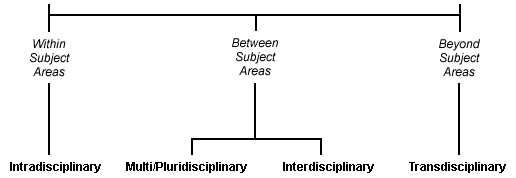Curricular Connections
Elements of Integration in the Classroom
Types of Curricular Connections
Curricular integration can be charted along a continuum, as illustrated below.
Curricular Connections Continuum

| Within Subject Area | Between Subject Areas | Beyond Subject Areas | |
|---|---|---|---|
| Intradisciplinary | Multi/ pluridisciplinary |
Interdisciplinary | Transdisciplinary |
|
Teachers
Require thorough knowledge of subject area's knowledge and skills and their interrelatedness Need to be aware of scope and sequence of subject area for K to S4 continuum Need to integrate cognitive, affective, and social domains with subject-based knowledge and skills in a context where the teaching-learning process fosters active and deliberate construction of meaning May cover less subject content, but that which is studied is done at a greater depth of understanding Need support from school administration and community Need access to professional development |
Teachers
Must regard intradisciplinary implementation issues where teachers - require thorough knowledge of subject area's knowledge and skills and their interrelatedness - need to be aware of scope and sequence of subject area for K to S4 continuum - need to integrate cognitive, affective, and social domains with subject-based knowledge and skills in a context where the teaching-learning process fosters active and deliberate construction of meaning - may cover less subject content, but that which is studied is done at a greater depth of understanding Deliberately coordinate timing and delivery of related topics; order of delivery may change Do not guide students in making linkages between knowledge and skills of separate subject areas; unable to form coherent view of topic May engage in limited shared planning Need support from school administration and community Need access to professional development |
Teachers
Must regard intradisciplinary implementation issues where teachers Require thorough knowledge of subject area's knowledge and skills and their interrelatedness Need to be aware of scope and sequence of subject area for K to S4 continuum Need to integrate cognitive, affective, and social domains with subject-based knowledge and skills in a context where the teaching-learning process fosters active and deliberate construction of meaning May cover less subject content, but that which is studied is done at a greater depth of understanding Must evaluate theme, issue, topic, or experience against four criteria 1. Validity within the disciplines-- teachers representing each subject area are required to verify that concepts identified are not merely related, but important to subject area 2. Validity for the disciplines-- learning of the discipline-based concepts actually enhanced by the integration; if not, these concepts best taught using intradisciplinary approach 3. Validity beyond the disciplines-- the interplay of subject areas illuminates complex phenomena; whole greater than sum of its parts 4. Contribution to broader outcomes-- integrated concepts enhance students' overall approach to knowledge, making them more skilled at flexible thinking and multiple points of view; integration has potential to contribute to intellectual as well as affective and social development of student Must ensure that integration is authentic and meaningful and occurs naturally within realistic contexts Must realize that not everything can be integrated Must start small with one integrated unit between 2 or 3 subject areas; should not involve all subject areas over the entire year Must consider the time needed for curriculum planning. Subject matter research may be necessary as familiar material is repositioned, raising new questions involving content not previously presented. New tests will have to be written. Extra time is needed to familiarize students with the interdisciplinary approach Need for common time for communication and coordination with colleagues at both planning and delivery stages Require student timetable that allows for students' time on task and interaction with appropriate human and material resources Require human, material, and financial resources Need support from school administration and community Need access to professional development |
Teachers
must alter their role and teaching approaches Do not formally address subject areas or their interconnectedness Require thorough knowledge of characteristics of, and relationship between the cognitive, affective, and social domains of developing child Select the subject-based knowledge and skills that stimulate and enrich students' learning experiences Reorganize the learning environment Need full support from school administration and community with respect to human, material, temporal, and financial resources Need access to professional development |


